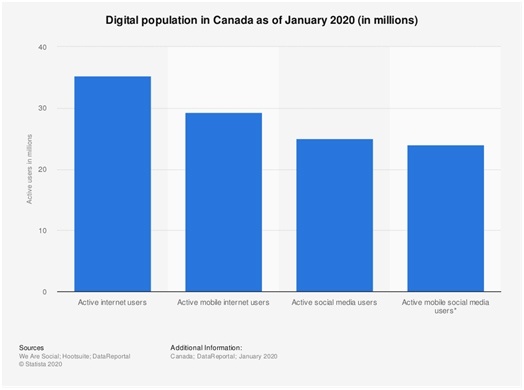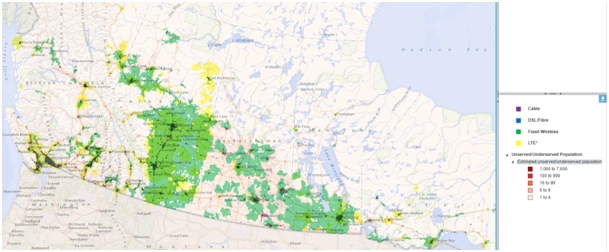
Broadband Internet in Ottawa: What’s already good for companies should become even better
Canada has a goal to become one of the leading countries in the world when it comes to broadband Internet availability. However, achieving this will require some work. Canada’s current state of rural broadband service means life beyond a 75 km radius of any major city is excluded from the digital economy and its services. This is an embarrassing state of affairs for a G7 country, in North America no less, and the one in which Alexander Graham Bell made the world’s first long-distance phone call in 1876, 13 kilometres between Brantford and Paris, Ontario. In fairness, Canada is a very urbanized nation with a population that gets very sparse, very quickly once outside of larger cities.

Broadband Internet in Ottawa compared to other Canadian cities
In 2015, 82 per cent of the Canadian population had access to fast connections. In 2016, the CRTC (Canadian Radio-television and Telecommunications Commission) declared that access to broadband Internet was a "necessary standard of living" for every citizen. Currently, the average Internet speed per user is 82 Mbit/s and this is will only get better since by 2030, the necessary expansion work should be completed. In the capital Ottawa, it will not take quite as long — but other priorities must be set here to help companies .Data shows that broadband service, defined as download speeds of at least 50 megabits per second (Mbps) and upload speeds of 10 Mbps, is currently available to 85 per cent of Canadians generally, but only 40.8 per cent of rural and remote communities. Past inquiries about the sorry state of rural options heard big Telco’s pointing to the high cost of upgrading switches along country roads for the sake of a handful of potential customers. Rural broadband has been just plain bad economics, but so was building the Canadian Pacific Railway. The vision could be identical. Invest in an infrastructure project to deliver goods, services, and a modern economy where one has yet to exist, and the investment eventually yields returns with the added benefit of fairness and nation building. Like the CPR, broadband Internet service for all Canadians requires a public/private partnership.
The Liberal Government made such a commitment in the 2019 budget and on November 9,2020. PM Justin Trudeau and cabinet ministers held a news conference in Ottawa on November 9th to launch the $1.75 billion Universal Broadband Fund. Most of the money is now available through a CRTC application process. The dollars come directly from contributions made by larger Canadian telecommunications service providers whose total annual Canadian revenues amount top $10 million. The goal is to connect 98 per cent of Canadians to broadband by 2026, up from the previous target of 95 per cent, and to connect the remainder by 2030.
The Canadian government believes that the positive social and national outcomes enabled by this new infrastructure may will pay off in the long term. Officials believe that there will be direct economic benefits to communities with connectivity and that broadband expansion is key to accelerating the pace at which economic prosperity can be enhanced in remote and rural areas. These investments will enhance Canada’s competitive performance and its social cohesion and will keep costs low and competition high.”
Canadian telecoms have already committed to connecting 70 more rural and remote communities by 2025, including 20 communities in the Arctic and 50 communities in Northeastern Quebec, with more installations planned for unconnected areas of Newfoundland and Labrador. This was before Trudeau’s announcement. Together, this connectivity will lead to vastly improved e-health delivery, the creation of virtual classrooms (a long-standing research priority for the North), and yet-to-be invented economic ventures.
Further south, the excitement in the potential benefits is also building. With COVID-19 pushing many services to only be available online, rural broadband is a problem that can no longer be ignored. Not only is this technology crucial for modern business, it is essential to the health of the food sector and agricultural industry in Canada to ensure the next generation of farmers have access to high-speed connectivity to run their farms, market their products and have the competitive advantage — an essential service for their everyday life.
The local Ottawa market will benefit from this fund
In principle, fast Internet already exists across the Ottawa area. Only the province of Quebec is similarly well connected. The official map (below) of the CRTC shows coverage across all major cities and there are no "blank spots" in Ottawa — i.e. areas without coverage.

Source: https://crtc.gc.ca/cartovista/internetcanada-en/
Internet in Ottawa is mainly wireless
Most of the connections offered in Ottawa are fixed wireless and LTE connection and WLAN. DSL and fiber optic connections are rather the exception.
One challenge with wireless internet is that the speed decreases with more users and the network can slow or break down more often. As more people (must) work from home and video conferencing becomes part of everyday life, these difficulties are particularly disadvantageous. Depending on the company, a wired broadband connection is required anyway. Research departments, for example, require constantly fast connections.
Fibre optic cables are laid in Canada primarily to provide access to rural areas and are the basis for stationary WLAN offers. They end in large distribution stations that distribute the signals further.
New plans for the capital
It is expected that the new funding plus the 5G expansion in Canada will be rolled out in Ottawa and other major urban areas. The faster 5G services will impact multiple technology and business including web hosting.
Conclusion
Broadband coverage throughout Canada going to improve greatly in the next few years in Canada, especially in remote and northern areas.











